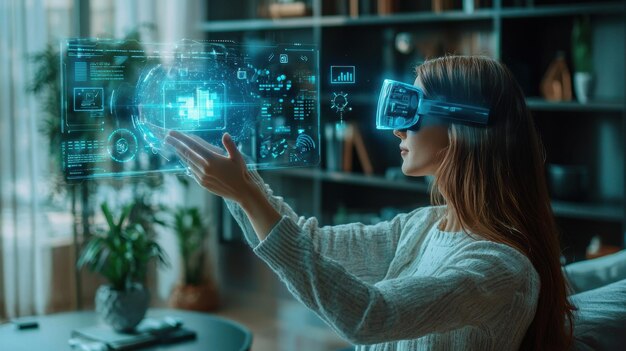For decades, the idea of a personal robot companion has been a cornerstone of science fiction, a futuristic dream of a helpful, intelligent assistant that manages our homes and simplifies our lives. From Rosie the Robot in “The Jetsons” to C-3PO in “Star Wars,” these characters captured our imagination. Today, that fiction is rapidly becoming fact. Recent breakthroughs in artificial intelligence, machine learning, and robotics are converging to usher in a new era of AI personal robots. These devices are moving beyond the realm of single-task novelties and positioning themselves as the true, mobile heart of the modern smart home. The latest AI Personal Robots News isn’t just about incremental updates; it’s about a fundamental shift in how we will interact with technology in our most personal spaces.
This article delves into the comprehensive landscape of AI personal robots, exploring the technologies that power them, their practical applications in daily life, the challenges they face, and the profound implications for the future of smart living. We are witnessing the evolution from stationary smart speakers to autonomous, perceptive companions that can see, hear, learn, and act within our environment, promising a level of integration and assistance previously thought impossible.
The Evolution of the Home Robot: Beyond the Vacuum
The journey of robotics into our homes began quietly, with single-purpose devices that performed specific, repetitive tasks. This slow but steady infiltration laid the crucial groundwork for consumer acceptance, paving the way for the more sophisticated companions emerging today.
From Single-Task to Multi-Faceted Companions
For most consumers, the first real taste of home robotics came from the Robotics Vacuum News headlines of the early 2000s. Devices like the Roomba accustomed us to the idea of an autonomous machine navigating our living spaces. While revolutionary for their time, these early robots were fundamentally limited. They performed one job and possessed minimal intelligence, often bumping into furniture and relying on simple algorithms. They were tools, not companions. The new generation of AI robots represents a quantum leap forward. Instead of just cleaning a floor, they aim to manage your schedule, entertain your pets, secure your home, and act as a dynamic interface to your entire digital life.
The Core Technologies Driving the Change
Three key technological pillars are responsible for this dramatic evolution:
- Advanced AI and Machine Learning: The rise of generative AI and Large Language Models (LLMs) is the single most significant catalyst. It transforms human-robot interaction from a series of rigid commands (“Hey robot, turn on the light”) to natural, conversational dialogue (“Hey, I’m about to sit down and read, could you make the lighting a bit warmer and quieter in here?”). This leap in natural language understanding is central to the latest AI Assistants News and makes these robots feel less like machines and more like intuitive partners.
- Sophisticated Sensing and Perception: Modern AI robots are equipped with a formidable sensor suite that allows them to perceive the world with near-human acuity. As covered in AI-enabled Cameras & Vision News, high-resolution cameras combined with computer vision algorithms enable them to recognize faces, identify objects (like a spilled drink or a pet), and even interpret human gestures. LiDAR and infrared sensors, similar to those in Autonomous Vehicles News, allow for precise spatial mapping and navigation, avoiding obstacles with grace. This constant stream of data from AI Sensors & IoT News creates a rich, real-time understanding of the home environment.
- On-Device Processing (Edge AI): A critical development for privacy and performance is the shift towards on-device processing. Early smart devices relied heavily on the cloud to handle complex computations. The latest AI Edge Devices News highlights a trend where more AI inference happens directly on the robot itself. This means personal data, like video feeds from inside your home, doesn’t need to be sent to a remote server, significantly enhancing privacy. It also reduces latency, allowing the robot to react instantly to its surroundings without a delay.
A New Paradigm: The Robot as a Mobile Smart Hub
The true innovation of these AI companions is their mobility. A stationary smart speaker can control your lights, but it can’t visually confirm if you left the stove on. An AI personal robot can physically travel to the kitchen, use its camera to check the stove, and send you a confirmation. It is the ultimate mobile smart hub, an active participant rather than a passive receiver of commands. It can project a video call onto the wall in your office and then follow you to the living room to project a movie, seamlessly integrating with AI Audio / Speakers News for a complete multimedia experience. This ability to be present where and when you need it redefines the very concept of a central smart home controller.
A Day in the Life with an AI Companion Robot

To truly grasp the impact of these devices, it’s helpful to move beyond technical specifications and envision their role in a typical day. This is no longer a far-off scenario but a tangible reality being showcased in the latest AI Research / Prototypes News.
Morning Routine and Productivity
Your day begins not with a jarring alarm, but with a gentle change in your room’s lighting, managed by your robot in sync with your sleep cycle data from AI Sleep / Wellness Gadgets News. As you wake, the robot rolls into view and projects the day’s weather and your calendar onto the ceiling. It follows you to the kitchen, reading highlights from your preferred news sources while you make coffee. It interfaces with Smart Appliances News, telling your coffee machine to brew your favorite blend. During your workday from home, it acts as a dynamic assistant. It can autonomously patrol the house to keep an eye on things, and if a delivery arrives, it can identify the courier and let you know. For those in creative fields, it can monitor a 3D print or other long-running tasks, providing updates and alerts, a perfect example of AI Tools for Creators News in action.
Home Management and Entertainment
Throughout the afternoon, the robot becomes an indispensable home manager. A key area of development is in AI Pet Tech News, where the robot can use its AI camera to detect when your dog is by the door and needs to go out, or initiate a laser-pointer game to keep your cat entertained. It can connect with AI Kitchen Gadgets News, projecting a recipe onto a countertop and guiding you through the steps. In the evening, it transforms into an entertainment powerhouse. It can project a family video call onto a wall, making it feel like your relatives are in the room. Later, it can create a home theater experience, projecting a movie onto a large, clear surface while syncing with the home’s sound system, showcasing its role in AI Toys & Entertainment Gadgets News.
Security and Wellness
When you leave the house, the robot’s role shifts to security and monitoring. It becomes a mobile sentry, a core feature in AI Security Gadgets News. You can remotely access its camera to check on your home from your phone, or it can be programmed to patrol and alert you to unusual sounds or movements. Its capabilities also extend to health and wellness. In the realm of AI Fitness Devices News, it can project a yoga or workout session and use its camera to offer real-time feedback on your form. For elderly family members, it can serve as a crucial companion, providing medication reminders and detecting falls, a life-changing application highlighted in AI for Accessibility Devices News.
The Broader Ecosystem: Integration and Interconnectivity
An AI personal robot does not exist in a vacuum. Its true power is unlocked when it becomes the central, intelligent conductor of a vast and interconnected ecosystem of smart devices and services.
The Robot as the Ultimate IoT Conductor
While smart speakers and phones can control IoT devices, a mobile robot adds a layer of physical context and verification. It can do more than just send a signal to a smart lock; it can go to the door, visually confirm it’s closed and locked, and report back. This ability to bridge the digital and physical worlds makes it a far more reliable and intelligent hub. It can interact with everything from AI Lighting Gadgets News to AI for Energy / Utilities Gadgets News, learning your patterns to optimize energy consumption by turning off lights and adjusting the thermostat in empty rooms. It synthesizes data from countless AI Monitoring Devices News to build a holistic, dynamic model of the home environment.
Extending Beyond the Home

The robot’s awareness can extend beyond the four walls of your house. By integrating with Wearables News and your smartwatch, it can know when you’ve finished a run and prepare a recovery smoothie. By connecting to your AI Phone & Mobile Devices News feed, it knows your location. Imagine your robot receiving a signal from your autonomous vehicle that you are five minutes away from home. It can then initiate a “welcome home” sequence: turning on the lights, adjusting the temperature, and even starting a playlist. This seamless integration between home, vehicle, and personal devices is the future of ambient computing.
Specialized Applications and Future Potential
The platform’s potential is immense. In education, it could become an interactive tutor for children, adapting lessons in real-time based on their engagement, a major topic in AI Education Gadgets News. In agriculture, scaled-down versions could manage indoor hydroponic systems, a form of AI Gardening / Farming Gadgets News. The technology could even influence AI in Fashion / Wearable Tech News, with the robot acting as a style assistant that can project outfits onto your reflection. The possibilities are as vast as our imagination.
Navigating the Challenges: Privacy, Practicality, and Price
Despite the incredible promise, the path to mass adoption is fraught with significant challenges that manufacturers and consumers must navigate carefully.
The Privacy Predicament
The most pressing concern is privacy. Inviting a device with always-on cameras and microphones to roam freely in your home is a significant leap of faith. The potential for data misuse or unauthorized access is a major hurdle. This is why the push for on-device processing discussed in AI Edge Devices News is so critical.
Best Practices for Privacy:
- Data Encryption: All stored and transmitted data must be end-to-end encrypted.
- Transparent Policies: Companies must be crystal clear about what data is collected, how it is used, and who has access to it.
- Physical Controls: The robot should have physical shutters for cameras and a mute button for microphones that are not hackable via software.

Practical Hurdles and Consumer Adoption
Beyond privacy, there are practical issues. Most homes are not sterile, perfectly flat environments. Stairs remain an insurmountable obstacle for most current designs. Cluttered floors, pets, and unpredictable children present complex navigation challenges. There is also the “uncanny valley” to consider—designing a robot that is personable and helpful without being perceived as creepy or intrusive. Finally, the price point for this cutting-edge technology will initially be very high, limiting its accessibility to early adopters and affluent consumers.
Recommendations for Consumers and Developers
For consumers interested in this emerging technology, the key is to start with a clear purpose. Identify a specific problem you want the robot to solve, whether it’s pet monitoring, home security, or accessibility assistance. Scrutinize the privacy policies of any device you consider. For developers, the focus must be on utility over novelty. A robot that can reliably perform three genuinely useful tasks is far more valuable than one with twenty gimmicky features. Prioritizing robust navigation, intuitive interaction, and a privacy-first architecture will be the keys to winning consumer trust and building a lasting market.
Conclusion: The Dawn of the Robotic Companion Era
We stand at a pivotal moment in the history of consumer technology. The AI personal robot is evolving from a sci-fi trope into a powerful, practical tool. Driven by the convergence of advanced AI, sophisticated sensors, and powerful edge computing, these devices are poised to become the central nervous system of our smart homes. They offer a future where our environment intelligently and proactively adapts to our needs, where technology is not just a tool we command but a partner that assists us.
While significant challenges around privacy, cost, and practicality remain, the trajectory is clear. The conversation is no longer about if AI robots will become part of our daily lives, but when and how. The latest AI Companion Devices News signals that this future is closer than ever, promising to fundamentally reshape our relationship with technology and redefine the meaning of a “smart” home.










